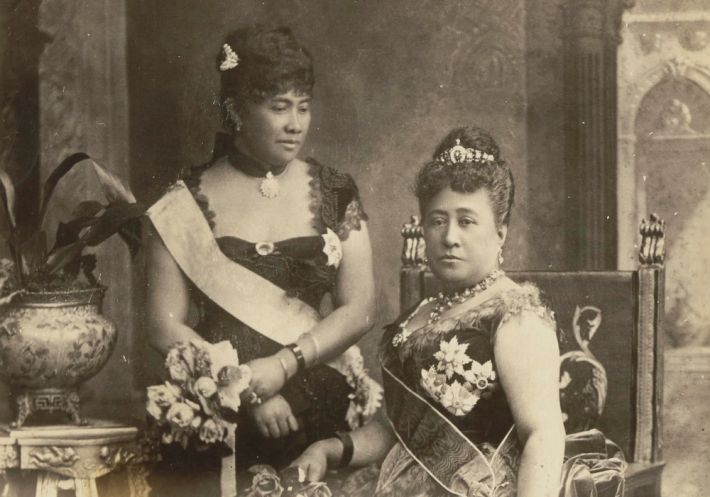This special Kūkahekahe by Cultural Consultant Manu Boyd KSK’80
celebrates the Sept. 2, 1838 lā hānau (birthdate) of Queen
Liliʻuokalani by recalling one of her homes in Kapālama, Oʻahu, known as
Muʻolaulani.
Long before “Muʻolaulani” was
associated with today’s Queen Liliʻuokalani Children’s Center on Hālona
Street in Kapālama, this royal name graced the Queen’s former residence
which was located less than a mile down the street a century earlier. On
King Street, between what are now Desha and Pua lanes, Muʻolaulani was
the name chosen in 1885 for the newly acquired property and home of
then-Princess Liliʻuokalani.
In December 1884, part of the former
estate of Princess Ruth Ke‘elikōlani (which was passed on to Simon
Ka‘ai) was acquired at auction by Lili‘u for $8,000, a large sum in
those days. The fairly new home was described as capacious and was
expanded further by the purchase of an adjacent property, which was
mainly lo‘i kalo.
After some minor improvements, Lili‘u moved into
her new Pālama residence in March of 1885. In “Hawaiʻi’s Story by
Hawaiʻi’s Queen” (Hui Hānai, 2013), Liliʻuokalani wrote, “This is the
day I am supposed to take possession of this house. I think that I shall
call it Mu‘olaulani.” It is likely that Liliʻuokalani had Princess
Ruth in mind when she decided to call her new home Muʻolaulani. Princess
Ruth formerly owned large land parcels identified as both Kapālama and
Pālama (lama wood enclosure). Keʻelikōlani was also referred to as both
Muʻolaulani and Kamuʻolaulani in mid-nineteenth century mele published
in Hawaiian language newspapers and its meaning is royal leaf buds, or
innumerable royal buds.
In May of 1885, a large
reception at Mu‘olaulani was likely the festive occasion where a new
mele by Princess Lili‘uokalani was debuted. “Nohea i Mu‘olaulani,”
meaning “Beautiful one at Muʻolaulani,” expresses the excitement and
contentment of this ali‘i wahine, who six years later would become
queen.
“He mea nui ke aloha” begins this elegant song: “Love is important.”
That
love is further compared to a diamond necklace in the mele’s third
line, which is often sung as “Mehe‘o ku‘u lei kaimana ala.” But it may
be that “‘ōpu‘u lei kaimana” was the composer’s intention as “‘ōpuʻu”
means bud, in reference to a solitaire diamond necklace.
The
chorus of this simple, elegant, eight-line mele begins with “Kuʻu lei
popohe i ka laʻi” (My adornment is shapely or in full form in the calm.)
Considering that muʻo and ʻōpu‘u are references to buds, the use of
“popohe” may allude to a kind of blossoming that she experienced. This
kind of word play is often seen in high-level Hawaiian poetic texts.
Just
weeks before Liliʻu’s purchase of the Pālama lands and residence, she
expressed disappointment in what she received from her hānai sister
Pauahi: diamond jewelry and lands at Kāhala, O‘ahu; Lumaha‘i, Kaua‘i;
and Keālia, Hawai‘i. But it was the downtown Honolulu home that she and
Pauahi grew up in that she really desired. Named Aikupika, Haleakalā
(Hale‘akala), it was later transformed into the Arlington Hotel and
located near what is now Bishop Square.
In 1889 after only four
years of residence at Muʻolaulani Liliʻu moved back to the palatial
residence ma uka of the ‘Iolani Palace, Washington Place, which was
built by her long-deceased father-in-law. Her move was prompted by the
passing of her mother-in-law, who for years had claimed Washington Place
as her own, even in the early years of Liliʻu’s residence there with
her husband. In the intervening years between her moving back to
Washington Place, Liliʻu and her mother-in-law had developed a warmer
relationship which they enjoyed into their later years.
The Queen
Liliʻuokalani Children’s Center building on Halona Street bears the
name Muʻolaulani today. It is mentioned in a late twentieth century mele
inoa by Mālia Craver and Val Kepelino, “Pu‘uhonua Nani,”recorded on
Peter Ahia’s “Peter Sings” album.
You can enjoy a recording of “Nohea i Muʻolaulani” by the Brothers Cazimero from their 1978 album Hoʻāla here.
Nohea i Mu‘olaulani
Princess Lili‘uokalani, May 1885
He mea nui ke aloha
Ke hiki mai i oʻu nei
Meheʻo ku‘u lei kaimana ala
(Me he ‘ōpuʻu lei kaimana ala)
Kāhiko no kuʻu kino
Ku‘u lei popohe i ka la‘i
Nohea i Muʻolaulani
Ka beauty lā, he mau ia
No nā kau a kau
Love is a great thing
When it comes to me
Like a diamond necklace
Adorning my body
My lei takes full form in the calm
Beautiful/handsome one at Muʻolaulani
The beauty will endure
From season to season
To
read more of Queen Liliʻuokalani’s recollections, read “Hawaiʻi’s Story
by Hawaiʻi’s Queen” (Hui Hānai, 2013) and “The Diaries of Queen
Liliʻuokalani of Hawaiʻi, 1885-1900” (Hui Hānai, 2020).
To learn
more about the Kapālama residences of Queen Liliʻuokalani and Princess
Ruth Keʻelikōlani, read this “Journal of Hawaiian History” article by researcher Ralph Thomas Kam.

Princess Liliʻuokalani and Queen Kapiʻolani attending Queen Victoria’s Jubilee in 1887. Liliʻuokalani would have been living at Muʻolaulani at this time.
TAGS
kūkahekahe,
queen liliʻuokalani
CATEGORIES
Kaipuolono Article, Regions, Themes, Culture, Community, Hawaii Newsroom, KS Hawaii Home, Kapalama Newsroom, Kapalama Home, Maui Newsroom, KS Maui Home, Newsroom, Hawaii, Kapalama, Maui, Department News, Ho‘okahua, Hawaii campus, Kapalama campus, Maui campus
Print with photos
Print text only










